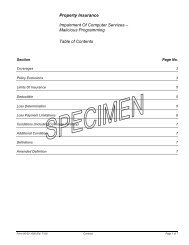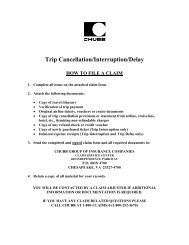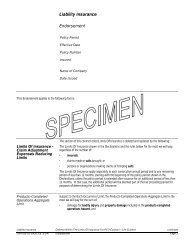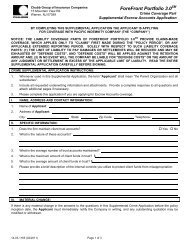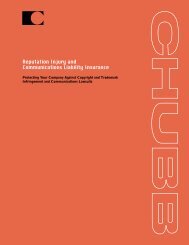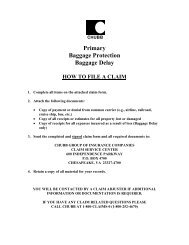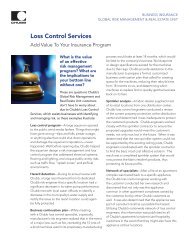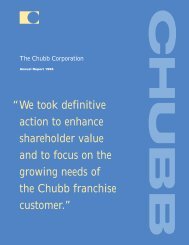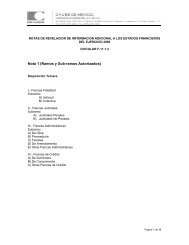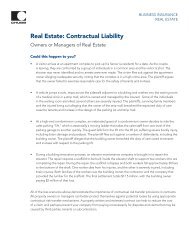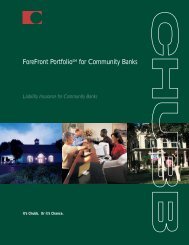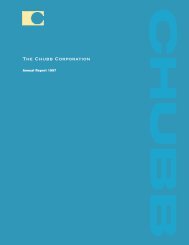Annual Report 2005 - Chubb Group of Insurance Companies
Annual Report 2005 - Chubb Group of Insurance Companies
Annual Report 2005 - Chubb Group of Insurance Companies
You also want an ePaper? Increase the reach of your titles
YUMPU automatically turns print PDFs into web optimized ePapers that Google loves.
those reinsurers with strong balance sheets and superior underwriting ability. The P&C <strong>Group</strong><br />
monitors the Ñnancial strength <strong>of</strong> its reinsurers on an ongoing basis.<br />
Unpaid Losses and Loss Adjustment Expenses and Related Amounts Recoverable from Reinsurers<br />
<strong>Insurance</strong> companies are required to establish a liability in their accounts for the ultimate costs<br />
(including loss adjustment expenses) <strong>of</strong> claims that have been reported but not settled and <strong>of</strong> claims<br />
that have been incurred but not reported. <strong>Insurance</strong> companies are also required to report as assets the<br />
portion <strong>of</strong> such liability that will be recovered from reinsurers.<br />
The process <strong>of</strong> establishing the liability for unpaid losses and loss adjustment expenses is complex<br />
and imprecise as it must take into consideration many variables that are subject to the outcome <strong>of</strong><br />
future events. As a result, informed subjective estimates and judgments as to our ultimate exposure to<br />
losses are an integral component <strong>of</strong> our loss reserving process.<br />
The P&C <strong>Group</strong>'s estimates <strong>of</strong> losses for reported claims are established judgmentally on an<br />
individual case basis. Such estimates are based on the P&C <strong>Group</strong>'s particular experience with the<br />
type <strong>of</strong> risk involved and its knowledge <strong>of</strong> the circumstances surrounding each individual claim. These<br />
estimates are reviewed on a regular basis or as additional facts become known. The reliability <strong>of</strong> the<br />
estimation process is monitored through comparison with ultimate settlements.<br />
The P&C <strong>Group</strong>'s estimates <strong>of</strong> losses for unreported claims are principally derived from analyses<br />
<strong>of</strong> historical patterns <strong>of</strong> the development <strong>of</strong> paid and reported losses by accident year for each class <strong>of</strong><br />
business. This process relies on the basic assumption that past experience, adjusted for the eÅects <strong>of</strong><br />
current developments and likely trends, is an appropriate basis for predicting future outcomes. For<br />
certain classes <strong>of</strong> business where anticipated loss experience is less predictable because <strong>of</strong> the small<br />
number <strong>of</strong> claims and/or erratic claim severity patterns, estimates are based on both expected losses<br />
and actual reported losses. Salvage and subrogation estimates are developed from patterns <strong>of</strong> actual<br />
recoveries.<br />
The P&C <strong>Group</strong>'s estimates <strong>of</strong> unpaid loss adjustment expenses are based on analyses <strong>of</strong> the<br />
relationship <strong>of</strong> projected ultimate loss adjustment expenses to projected ultimate losses for each class<br />
<strong>of</strong> business. The claim staÅ has discretion to override these expense estimates on reported claims<br />
where judgment indicates such action is appropriate.<br />
The P&C <strong>Group</strong>'s estimates <strong>of</strong> reinsurance recoverable related to reported and unreported losses<br />
and loss adjustment expenses represent the portion <strong>of</strong> the gross liabilities that will be recovered from<br />
reinsurers. Amounts recoverable from reinsurers are estimated in a manner consistent with the gross<br />
losses associated with the reinsured policies.<br />
Estimates are regularly reviewed and updated as appropriate. Any changes in estimates are<br />
reÖected in operating results in the period in which the estimates are changed.<br />
The anticipated eÅect <strong>of</strong> inÖation is implicitly considered when estimating liabilities for unpaid<br />
losses and loss adjustment expenses. Estimates <strong>of</strong> the ultimate value <strong>of</strong> all unpaid losses are based in<br />
part on the development <strong>of</strong> paid losses, which reÖect actual inÖation. InÖation is also reÖected in the<br />
case estimates established on reported open claims which, when combined with paid losses, form<br />
another basis to derive estimates <strong>of</strong> reserves for all unpaid losses. There is no precise method for<br />
subsequently evaluating the adequacy <strong>of</strong> the consideration given to inÖation, since claim settlements<br />
are aÅected by many factors.<br />
Additional information related to the P&C <strong>Group</strong>'s estimates related to unpaid losses and loss<br />
adjustment expenses and the uncertainties in the estimation process is presented in the Property and<br />
Casualty <strong>Insurance</strong> Ì Loss Reserves section <strong>of</strong> MD&A.<br />
The P&C <strong>Group</strong> continues to emphasize early and accurate reserving, inventory management <strong>of</strong><br />
claims and suits, and control <strong>of</strong> the dollar value <strong>of</strong> settlements. The number <strong>of</strong> outstanding claims at<br />
6



